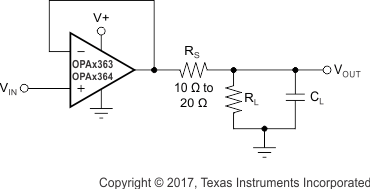SBOS259F September 2002 – June 2018 OPA2363 , OPA2364 , OPA363 , OPA364 , OPA4364
PRODUCTION DATA.
- 1 Features
- 2 Applications
- 3 Description
- 4 Revision History
- 5 Device Comparison Table
- 6 Pin Configuration and Functions
-
7 Specifications
- 7.1 Absolute Maximum Ratings
- 7.2 ESD Ratings
- 7.3 Recommended Operating Conditions
- 7.4 Thermal Information: OPA363
- 7.5 Thermal Information: OPA364
- 7.6 Thermal Information: OPA2363
- 7.7 Thermal Information: OPA2364
- 7.8 Thermal Information: OPA4364
- 7.9 Electrical Characteristics
- 7.10 Typical Characteristics
- 8 Detailed Description
- 9 Application and Implementation
- 10Power Supply Recommendations
- 11Layout
- 12Device and Documentation Support
- 13Mechanical, Packaging, and Orderable Information
Package Options
Mechanical Data (Package|Pins)
Thermal pad, mechanical data (Package|Pins)
- D|8
Orderable Information
8.3.3 Capacitive Load
The OPAx363 and OPAx364 series op amps can drive a wide range of capacitive loads. However, all op amps under certain conditions may become unstable. Op amp configuration, gain, and load value are a few of the factors to consider when determining stability. An op amp in unity-gain configuration is the most susceptible to the effects of capacitive load. The capacitive load reacts with the output resistance of the op amp to create a pole in the small-signal response, which degrades the phase margin.
In unity gain, the OPAx363 and OPAx364 series op amps perform well with a pure capacitive load up to approximately 1000 pF. The equivalent series resistance (ESR) of the loading capacitor may be sufficient to allow the OPA363 and OPA364 to directly drive very large capacitive loads ( greater than 1 µF). Increasing gain enhances the ability of the amplifier to drive more capacitance; see Figure 13.
One method of improving capacitive load drive in the unity-gain configuration is to insert a 10-Ω to 20-Ω resistor in series with the output, as shown in Figure 22. This resistor significantly reduces ringing with large capacitive loads. However, if there is a resistive load in parallel with the capacitive load, the load creates a voltage divider, introduces a DC error at the output, and slightly reduces output swing. This error may be insignificant. For example, with RL = 10 kΩ and RS = 20 Ω, there is an approximate 0.2% error at the output.
 Figure 22. Improving Capacitive Load Drive
Figure 22. Improving Capacitive Load Drive